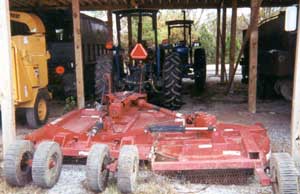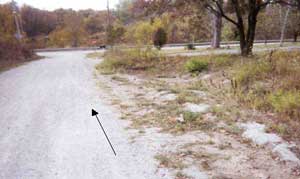
OKFACE Report #00-OK-040-01

OKFACE Report #00-OK-040-01
County Road Maintenance Worker Died When He Was Run Over By A Rotary Cutter
SUMMARY
A 64-year old county road maintenance worker died on July 7, 2000, from injuries received when he was run over by a rotary cutter (brush hog) powered by the tractor that he had been operating. OKFACE investigators concluded that to prevent similar occurrences employers should:
OKFACE investigators also concluded that tractor manufacturers should:
INTRODUCTION
A 64-year old county road maintenance worker died on July 7, 2000, from injuries received when he was run over by a rotary cutter (brush hog) powered by the tractor he had been operating. The deceased was semi-retired and had worked for the county for one previous summer season. OKFACE investigators reviewed the death certificate, the medical examiner’s report, the State Occupational Safety and Health Administration fatality report, and the state highway patrol traffic collision report. While conducting the site survey, the investigators interviewed the county commissioner, deputy commissioner, and a subject matter expert with the dealership from which the tractor and brush hog had been purchased. Information was obtained from other site investigators who, soon after the incident, interviewed children that witnessed the incident.
The deceased worked for a county district office that employed 20 full-time and 10 seasonal workers at the time of the incident. The victim was one member of a two-person crew that had been deployed to mow the shoulders and ditches along several miles of county roads. The workers each operated a 1998 model tractor equipped with a power take off-driven (PTO) 1998 model heavy duty flex-wing rotary cutter that was approximately 11 feet in width with the wings in the mow position. Both the tractor and the cutter were in excellent operating condition and equipped with all standard guards (Figure 1). The county district office did not have a written safety program or written work procedures other than the instructions provided by the equipment manufacturers.
The county district office held monthly safety meetings conducted by the Civil Defense Director who was the designated Safety Coordinator for the agency. No formal safety training was conducted for new employees; however, the county commissioner or his designee conducted on-the-job training for all equipment operators, and each operator was required to demonstrate satisfactory operating skills before being permitted to begin site work.
 |
| Figure 1. Rotary cutter and tractor |
INVESTIGATION
The temperature at the time of the incident was approximately 79°F, and the wind was southerly with an average speed of 5 mph. On the day of the incident, the crew reported for work at the county district office yard and were deployed to mow the shoulders and ditches along roads in the rural northeast part of the county. The victim and the other crew member were working on two separate cul-de-sacs several hundred feet apart at the time of the incident.
Shortly after noon, the victim had mown along the south side of the east-west gravel-surfaced road and had made the turn at the end of the cul-de-sac to mow along the north side (Figure 2). As he was passing an area in which three homes were located, he noticed some toys in the path of the cutter. The victim shifted the transmission to neutral and dismounted the tractor, leaving the motor running and the PTO engaged; the parking brake was not set. He proceeded to remove the toys from the ditch in front of the tractor. The tractor wheels were positioned on the gravel surface facing downhill on a 3% grade. The mower deck was positioned approximately 10-12 inches above ground level, and extended approximately three feet beyond the tractor’s rear wheel on the right side of the vehicle. When the tractor began to roll, the victim ran around the mower deck to the right side of the tractor and tried to climb up to the driver’s seat. Unable to climb onto the tractor, the victim fell to the ground and was run over by the rotary mower. He was killed instantly. The tractor continued to roll approximately 20 feet, dragging the victim under the mower deck, before coming to rest in the ditch near a drive on the north side of the road. The body was trapped beneath the vehicle for approximately one hour.
Some nearby children witnessed the incident and reported it to their caretaker who called for an ambulance. The ambulance arrived approximately 20 minutes after the incident occurred. After the victim was removed from beneath the mower, the ambulance transported the body to a funeral service facility where it was viewed by the medical examiner.
 |
| Figure 2. Direction of travel on the cul-de-sac the victim was mowing |
CAUSE OF DEATH
The Medical Examiner listed the immediate cause of death as decapitation.
RECOMMENDATIONS
Recommendation #1: Employers should develop written operating procedures for use by employees who operate tractors and similar types of equipment.
Discussion: Although equipment operation had been generally covered in quarterly safety training conducted by the employer, OKFACE investigators identified no objective evidence that specific safety procedures had been developed and implemented for safe operation of the tractor and rotary mower. Such procedures, developed in accordance with manufacturer recommendations and regulatory requirements, could prevent similar incidents when properly applied by the operator. For example, a safety instruction sign affixed to the tractor involved in the incident provided the following legend:
“Before dismounting, secure implement in transport position or lower to ground. Put tractor in park or set brake, stop engine, and remove key. Never mount or dismount a moving vehicle to prevent crushing injury or death.”
While manufacturer recommendations are an important source of information for the development of safe work policies, procedures and work practices, they do not necessarily include all legal requirements and their exclusive use may not adequately provide an acceptable set of safe work practices. Whenever an operator has dismounted a vehicle but is within 25 feet and within view of the vehicle, according to regulatory requirements, the operator must neutralize the controls and set the brake to prevent movement. In addition to these requirements, regulations require an operator to shut off the motor and block the wheels (if the vehicle is positioned on an incline) when more than 25 feet from, or out of view of, the vehicle. Established written policies, procedures and work practices provide the basis for an adequate safety training program.
Recommendation #2: Employers should train all operators in the use of
safe operating procedures and conduct an evaluation of the training.
Discussion: OKFACE investigators did not identify any objective evidence that safety training specific to the hazards that caused this fatality had been conducted. Once the necessary procedures have been developed, the employer must implement a training program that specifically includes and emphasizes all safety procedures. According to regulatory requirements, this training must include formal instruction, practical training, and an evaluation of the operator’s performance in the workplace.
Recommendation #3: Employers should periodically monitor and evaluate
employee conformance with safe operating procedures and provide re-training
and corrective action as necessary when the procedures are not followed.
Discussion. Co-workers suggested that the victim involved in this incident had operated farm equipment for years and was aware of the proper safety precautions. OKFACE investigators did not identify any objective evidence that employee performance was evaluated on a regular basis. According to regulatory requirements, the employer must conduct refresher training for operators of vehicles such as the one involved in this incident, including an evaluation of the training’s effectiveness, whenever a performance deficiency is identified, an incident or near-miss incident occurs, or workplace conditions change. Regulatory requirements also mandate a performance evaluation at least once every three years.
Recommendation #4: Employers should develop and implement a formal occupational
health and safety management system that is focused on continual improvement.
Discussion: The dynamic nature of the contemporary workplace necessitates a management model that ensures continual improvement in virtually all aspects of the business. This principle is particularly critical with regard to the management of workplace health and safety, which must be integrated into all operational aspects of an organization’s business plan. While implementation of a formal management system may or may not have directly prevented the incident, it could have encouraged and facilitated the identification and correction of deficiencies, including performance deficiencies, which may have served as contributing causes. Implementation of a safety management system is a useful and achievable goal for any employer that seeks to reduce occupational injuries and illnesses.
Recommendation #5: Tractor manufacturers should consider installing
as standard equipment an electronic interlock system that shuts off the vehicle
motor whenever the transmission is in neutral and the safety belt is disconnected
or the seat is dismounted without the parking brake having been set and should
offer retrofit packages for vehicles not so equipped.
Discussion: A safety belt or driver seat interlock that shuts off the motor whenever the transmission is in neutral and the parking brake has not been set prevents the operator from inadvertently dismounting the vehicle with the motor running, the PTO engaged, and the tractor capable of unintended movement. The use of a safety belt interlock that shuts off the motor if the belt is not in use has the added advantage of encouraging the driver to wear the seat belt when operating the vehicle, a critical issue for rollover protection. It also requires a deliberate act by the operator to by-pass the interlock in order to avoid using the seat belt. A parking brake interlock ensures that neither the motor nor PTO will operate if the parking brake is not set when the transmission is in neutral.
REFERENCES
The Oklahoma Fatality Assessment and Control Evaluation (OKFACE) is an occupational fatality surveillance project to determine the epidemiology of all fatal work-related injuries and identify and recommend prevention strategies. FACE is a research program of the National Institute for Occupational Safety and Health (NIOSH), Division of Safety Research.
These fatality investigations serve to prevent fatal work-related injuries in the future by studying the work environment, the worker, the task the worker was performing, the tools the worker was using, the energy exchange resulting in injury, and the role of management in controlling how these factors interact.
To contact Oklahoma State FACE program personnel regarding State-based FACE reports, please use information listed on the Contact Sheet on the NIOSH FACE web site Please contact In-house FACE program personnel regarding In-house FACE reports and to gain assistance when State-FACE program personnel cannot be reached.